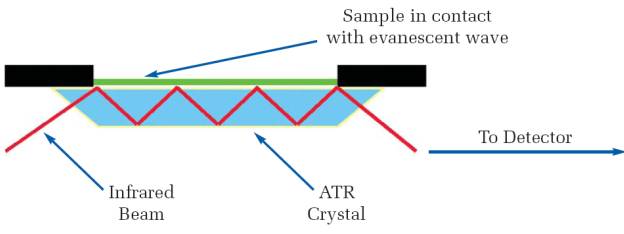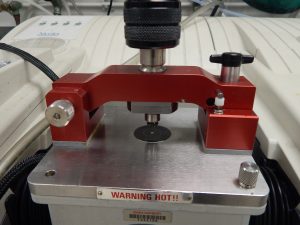Fourier Transform Infrared (FTIR)-
Attenuated Total Reflection (ATR)
Spectroscopy
THEORY
FTIR is a fundamental tool that is used to probe substances to determine the nature of their molecular bonds. FTIR has commonly been used for the identification of functional groups among organic molecules. It can often easily distinguish between a variety of molecular bonds involving carbon, hydrogen, nitrogen, oxygen, phosphorus, sulfur, and halogens. There are many methods available for infrared spectroscopy. Traditionally, FTIR is used with a transmission cell or a KBr pellet. However, in the surface science community, infrared spectroscopy is used in a different manner.
Attenuated Total Reflection (ATR) is an accessory of transmission IR spectrometers that significantly enhances surface sensitivity. As the name implies, ATR refers to a particular type of reflection geometry. In contrast to transmission FTIR, in which the infrared beam travels in a straight path through a sample, in ATR, the infrared beam is reflected internally through a crystal. The beam is oriented to bounce within the crystal at an angle that ensures total internal reflection. Just above each point of reflection exists an evanescent wave that can probe substances within about a micrometer of the crystal surface. A schematic of a typical setup is seen below:

APPLICATION
The sample, which can include liquids and solids, is simply pressed against the ATR crystal. The ATR crystal is made of a high index of refraction crystal that absorbs minimally in the region of interest. Typical materials include but are not limited to zinc selenide, diamond, silicon, and germanium.There are various reasons for choosing ATR, but the most predominant is its surface sensitivity. Transmission IR will probe the bulk as well as the surface of a particle. There is no control as to how much of each is seen in the transmission spectrum. ATR only measures substances within about a micrometer from the crystal surface. Another advantage is the versatility that ATR allows. In situ measurements (or measurements while the reaction is proceeding) can only be accomplished with a typical transmission cell if gas is the species studied. In situ measurements can easily be accomplished with ATR. The setup above can be converted to an in situ cell by adding a top plate that allows for flow of liquids or gasses. ATR is especially applicable in monitoring different species in catalytic systems.
Presently in the Strongin lab, there are four Nicolet Spectrometers equipped with ATR accessories, with multibounce and singlebounce configurations, heating capability, as well as in situ capability. In addition, there are two accessories than can handle high-pressure conditions. Each ATR accessory is easily interchangeable between spectrometers.
Shown above is one of our ATR accessories. This is a single bounce ATR with a diamond crystal.
